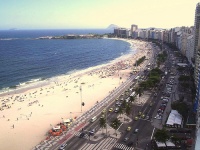Airport
Galećo Antonio Carlos Jobim International Airport
IATA Code: GIGLocation: The airport is located on Governor's Island, 12 miles (20km) north of Rio de Janeiro.
Time: GMT -2 (GMT -3 between the third Sunday in October to the third Sunday in March).
Contacts: Tel: +55 21 3398 4106, 3398 4208 or 3398 5050.
Transfer between terminals: A moving walkway connects the two terminals.
Transfer to the city: The easiest and fastest transport from the airport is by taxi. Taxi vouchers should be bought from the Rio de Janeiro State Tourism Authority desk in the arrivals terminal to avoid any hassle and should cost about US$25. Public buses are available and passengers can connect to Rio's Novo Rio Rodoviaria bus station in the city centre. Fares are roughly US$3. More expensive airport shuttles are available to downtown hotels and popular destinations but can have an English speaking guide.
Taxis: Taxis are available outside the terminal. Visitors are advised to buy prepaid taxi vouchers at the Rio Tourism Authority desk; they are usually a little bit more expensive but give you peace of mind. It is advisable to ignore the RDE taxi desk and go to the Rio de Janeiro State Tourism Authority desk instead and buy prepaid taxi vouchers there. If you hail a taxi outside the terminal make sure the metre is cleared of the last fare.
Car rental: Car rental companies, including Avis and Hertz can be found in Terminal 1.
Facilities: The airport is well equipped with facilities including ATMs, banks and bureaux de change, shops, restaurants and bars, duty-free shopping, luggage lockers and a tourist help desk. Facilities for the disabled are good.
Parking: A multi-storey carpark is available.
Departure tax: US$12 to US$36 depending on category
Website: www.infraero.gov.br
Visit worldtravels.com for the full guide to Rio de Janeiro. Build a complete Rio de Janeiro travel guide and email to your clients - sign up for a trial subscription of World Travels Pro.
Rio de Janeiro

Mention Rio to anyone and immediately the name evokes images of sultry street parades, the Sugarloaf Mountain cable car, the Christ the Redeemer statue atop Corcovado mountain, and the 'itsy-bitsy teeny weeny' bikinis on the beach at Ipanema. The exuberant cultural capital of Brazil is tucked between the mountains and the sea and is endowed with awe-inspiring natural beauty. Rio's beaches, including the famous Ipanema and Copacabana, are a main attraction due to the city's warm climate. It also contains the biggest urban forest in the world, the Tijuca Forest, which was completely replanted during the second half of the 19th century.
The city pulses to the infectious beat of Brazilian music: the choro, the samba and the bossa nova, and the funk carioca, and is the cultural capital of Brazil. Its annual carnival, known simply as Carnaval, draws together the population of the city (known as the 'Cariocas') ranging from the very rich to the very poor, who take to the streets for the world's largest samba parade on the Sambodromo.
Rio is a never-ending story made up of 150 districts, each characterised by unique features like Santa Teresa, a winding maze of streets populated by artists and musicians, which is reached by taking an old tram across an ancient aqueduct called Arcos da Lapa. In the central city area of Rio there are historic monuments and public buildings like the Municipal Theatre, the National Museum of Fine Art, the Itamaraty Palace, the National History Museum, and the National Library. There are also beautiful examples of religious architecture such as the Sao Bento Monastery. No matter how long you spend exploring the city, it will always deliver new surprises.
Rio will be overrun with international sporting events in the next few years, as it is set to be the first South American city to host the Summer Olympics in 2016, and will be the primary host city for the FIFA World Cup Soccer Tournament in 2014.
To the north of the city is the Lakes region, which has more than 62 miles (100km) of beaches and sea-water lagoons and is the site of the main tourist resorts of Bśzios, Cabo Frio, Arrial do Cabo, Rio das Ostras, Marica and Saquarema.







